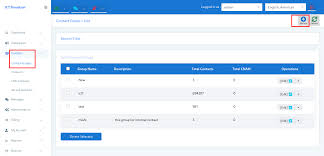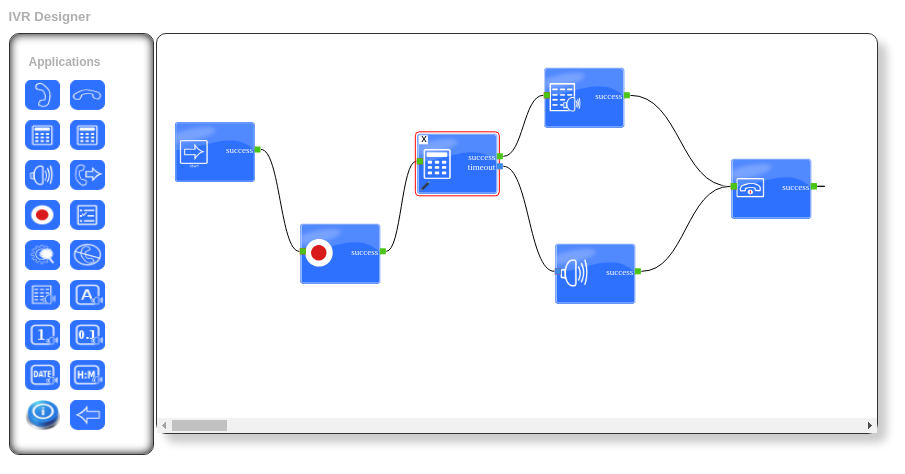ICTBroadcast is an Ai-powered auto dialer software and unified communications platform that offers companies robust voice, SMS, email, and fax communication options. ICTBroadcast allows for seamless browser-based communication for voice, video, and data sharing thanks to the incorporation of WebRTC (Web Real-Time Communication). WebRTC streamlines communication procedures by eliminating the requirement for external hardware, software, or plugins. WebRTC improves user comfort and accessibility by allowing real-time interactions straight from a web browser, whether for inbound customer care or outbound marketing campaigns.
ICTBroadcast enables companies to simplify their operations and expand their communications with ease by using WebRTC. The integration enhances efficiency without requiring any extra infrastructure or setup by enabling remote teams and call centers to handle communications via an easy web interface. The solution offers secure, top-notch connections for businesses of all sizes, regardless of their size. ICTBroadcast transforms how businesses interact with customers by using WebRTC to enable real-time, browser-based communication.
What does WebRTC mean in ICTBroadcast?
WebRTC is an open-source technology that allows users to share audio, video, and data in real time directly through their web browsers. It enables smooth peer-to-peer communication without the need for extra plugins or software installations. WebRTC is a key facilitator of browser-based communications in ICTBroadcast, offering businesses a flexible and affordable way to enhance customer interaction.
With ICTBroadcast’s WebRTC, users may engage in high-quality voice and video conversations directly from their browsers, providing a seamless and intuitive experience. WebRTC in ictbroadcast improves its platform’s features, providing a scalable answer that aids enterprises in managing communications, delivering customer support, and running effective marketing campaigns without the need for complicated infrastructure. The technology enables real-time communication for both agents and customers, removing the need for external devices like SIP hardware or softphones.
How WebRTC is Used by ICTBroadcast
ICTBroadcast transforms how businesses manage voice, video, and data interactions by using WebRTC technology to provide smooth, browser-based communications. WebRTC integration allows marketing departments, customer support teams, and call centers to communicate in real-time directly through their web browsers without the need for any extra software or equipment. This integration greatly streamlines the user experience by facilitating easy connections between agents and customers, which improves communication.
The strength of WebRTC in ICTBroadcast comes from its capacity to facilitate trustworthy, secure, and high-quality interactions without the need for complex setups. Users may handle incoming support, conduct video conferences, launch marketing campaigns, and make calls—all from a single web interface. This minimizes both hardware and maintenance expenses by removing the necessity for distinct telephony equipment or softphones. Additionally, WebRTC’s low-latency connection enables companies to depend on real-time interactions, which are essential for enhancing operational effectiveness and customer satisfaction.
Key Features of WebRTC Integration in ICTBroadcast
Voice Broadcasting (Automated Call Campaigns)
ICTBroadcast incorporates WebRTC to allow for smooth voice broadcasting campaigns that can be launched straight from the browser. Companies may quickly start automated outbound calls to thousands of people in real-time, delivering either interactive prompts or pre-recorded messages. By saving time and labor, this function enables organizations to successfully conduct product promotions, political surveys, marketing campaigns, and emergency alerts. For maximum impact when reaching a big audience, the WebRTC integration guarantees crystal-clear, uninterrupted audio quality.

SMS Broadcasting to Increase Reach
With its sophisticated SMS broadcasting capability, ICTBroadcast enables organizations to send mass messages straight from the web interface using WebRTC. This is especially helpful for alerts, event reminders, special promotions, and customer interaction. WebRTC simplifies the process, allowing companies to communicate with thousands of customers. ICTBroadcast provides reliability and speed by leveraging WebRTC, guaranteeing that all messages arrive at their intended recipients without delay.
Customer Support in Real Time (Incoming Calls)
By allowing high-quality voice and video conversations through any web browser, WebRTC improves ICTBroadcast’s real-time customer support. Customers can instantly connect with support agents when they require help, which enhances both service quality and efficiency. Whether dealing with complaints, questions, or technical issues, support agents may quickly resolve problems thanks to WebRTC’s low-latency communication. With this capability, companies may provide better customer support that promotes satisfaction and loyalty among their clients.
Integration of Interactive Voice Response (IVR)
ICTBroadcast integrates effortlessly with Interactive Voice Response (IVR) systems using WebRTC. This enables companies to automate call handling, facilitating customers’ menu navigation, department selection, and self-service activities like troubleshooting common issues or checking balances. By providing a higher degree of customer interaction and lowering the load on support personnel, the WebRTC feature enhances operational efficiency by making these interactions more fluid and responsive.

Collaborative Calling and Conferencing
ICTBroadcast makes it simple for organizations to hold team meetings, sales calls, or customer consultations by using WebRTC to provide conference calling straight through a browser. This function enables real-time interaction between participants through voice and video conferencing, irrespective of their geographic location. WebRTC is perfect for remote team management, brainstorming sessions, and collaborative work since it keeps the connection clear and stable even with many users. Businesses can utilize this function to enhance communication among remote teams, as well as for training and team building.
Campaign Reporting and Analytics
The WebRTC integration in ICTBroadcast offers more than just communication; it also offers real-time reporting and analytics. From the web interface, companies may evaluate agent performance, track success rates, analyze call data, and monitor campaign success. This functionality enables companies to enhance overall campaign results, refine their marketing tactics, and make choices based on data. Businesses may strategically change their activities in real-time by looking at live data, which improves efficiency and return on investment.
Click-to-Call Features
WebRTC’s click-to-call function allows visitors to websites to immediately reach agents by clicking a simple link or button. Customers may make voice or video calls straight from their browser by clicking the button, eliminating the need to manually dial phone numbers. This immediate interaction improves user satisfaction, decreases response times, and raises the chance of conversions. Businesses may provide this smooth, interactive communication experience on their websites thanks to ICTBroadcast’s integration with WebRTC.
End-to-End Encrypted Secure Communication
Companies that use ICTBroadcast prioritize security above all else. WebRTC protects sensitive customer information and communications by ensuring that all voice, video, and data transmissions are encrypted with end-to-end security. This feature is especially important for fields like healthcare, finance, and legal services, where confidentiality is essential. ICTBroadcast guarantees that companies may offer secure and private communications by integrating WebRTC, which helps build customer trust and adhere to regulatory requirements such as HIPAA or GDPR.
Scalable VoIP Alternatives
The WebRTC integration in ICTBroadcast enables scalable VoIP solutions, permitting companies to grow their communication infrastructures as required. WebRTC guarantees that the platform can accommodate a rising number of agents, clients, and calls without losing quality, regardless of whether it is used for large business settings or small-scale operations. ICTBroadcast is a flexible and future-proof answer for any kind of communication needs because of its scalability, which allows companies to adapt to shifting operational needs or rising demand.
Support for Multiple Channels of Communication
ICTBroadcast with WebRTC provides extensive multilingual communication support for voice, SMS, and email broadcasting, all of which may be controlled via a single web interface. This feature enables companies to connect with customers using the most appropriate channels, whether that be through voice campaigns, automated SMS messages, or email interactions. WebRTC guarantees that every communication channel runs seamlessly, providing companies with flexibility and control over their outreach methods, all while ensuring high-quality, real-time interactions.
Challenges with WebRTC in ICTBroadcast
Problems with Browser Compatibility: WebRTC might not function smoothly across all browsers, especially older ones, which could result in inconsistent user experiences for certain clients or agents.
Network Lag and Performance Fluctuation: Problems such as delays and poor quality on unstable internet connections can impact WebRTC performance, which can be detrimental to real-time assistance or large-scale campaigns.
Security Threats in Open Networks: Although WebRTC provides encryption, using it over unprotected networks, such as public Wi-Fi, can expose communications to possible security threats.
Integration Complexity with Current Systems: It may be technically difficult to integrate WebRTC into current telephony or CRM systems within ICTBroadcast, and it may need further bespoke development.
Server Load and Scalability: Businesses may need to optimize their infrastructure for seamless WebRTC performance as a result of the substantial strain that high traffic and large-scale communication campaigns can place on servers.
Overcome Challenges with WebRTC in ICTBroadcast
Guaranteeing Browser Compatibility: ICTBroadcast can promote users to update their browsers to improve browser compatibility. A smoother experience across various devices can also be accomplished by implementing fallback choices or identifying compatibility concerns early on.
Lowering Network Latency and Enhancing Performance: By investing in high-quality internet connections and using Content Delivery Networks (CDNs) to lower latency, businesses may improve WebRTC performance. A more consistent experience is provided by adaptive bitrate technology, which adjusts call quality according to available network bandwidth.
Improving Protection on Public Networks: To reduce security threats, companies can use VPNs or other secure connection techniques when using WebRTC over public networks. WebRTC encryption can be combined with extra security layers like TLS or SRTP to keep sensitive communications safe.
Making Integration with Current Systems Easier: Businesses can make it easier to integrate WebRTC with ICTBroadcast by using API-based solutions or getting help from developers who are familiar with both WebRTC and ICTBroadcast systems. This speeds up the deployment process and lowers integration complexity.
Improving Server Infrastructure for Growth: By ensuring that the infrastructure is elastic and cloud-based and by improving server load balancing, ICTBroadcast can address scalability problems. This ensures that the system maintains steady performance even during peak usage times by enabling it to automatically increase or decrease depending on real-time demand.
Advantages and Disadvantages of WebRTC in ICTBroadcast
Advantages:
Affordable Communication: By removing traditional telephony systems and infrastructure, WebRTC saves expenses and enables companies to conduct communication initiatives online.
Improved Customer Interaction: By facilitating real-time voice, video, and messaging, it enhances engagement and customer satisfaction in marketing and support campaigns.
Simple Browser-Based Access: WebRTC enables immediate communication for both agents and clients without the need for extra software and with smooth access.
Cons
Dependency on the Internet: WebRTC depends on internet quality, and bad network conditions can result in distorted audio or dropped calls.
Compatibility Problems: WebRTC may not be fully supported in some older browsers or less frequently used systems, which could lead to access problems for some users.
Management of Security: Although WebRTC provides encryption, further safeguards are needed to secure communications and prevent data breaches, particularly over public networks.
Frequently Asked Questions
What does WebRTC stand for in ICTBroadcast?
WebRTC, or Web Real-Time Communication, is a technology that allows for real-time voice, video, and messaging interaction directly through web browsers. It is integrated into ICTBroadcast.
What are the benefits of WebRTC for companies using ICTBroadcast?
WebRTC offers a low-cost, browser-based option that removes the requirement for extra hardware, improving customer interaction and simplifying communication campaigns.
In ICTBroadcast, WebRTC enhances communication by enabling real-time audio and video interactions between users. This facilitates more efficient collaboration and communication, lowers latency, and enables instant media sharing. WebRTC also supports interoperability with various devices and platforms, making it easier for users to connect and communicate. WebRTC improves communication by allowing voice, video, and SMS interactions to take place directly through the browser, which enhances both the effectiveness of customer engagement and support.
Which browsers in ICTBroadcast support WebRTC?
Most current browsers, including Google Chrome, Mozilla Firefox, Safari, and Microsoft Edge, support WebRTC. Older or less popular browsers might not be entirely compatible.
How secure is WebRTC in ICTBroadcast?
WebRTC offers integrated encryption for secure communications. However, especially over public networks, additional precautions like utilizing VPNs or other security protocols may be required to guarantee total security.